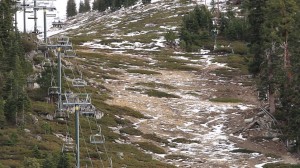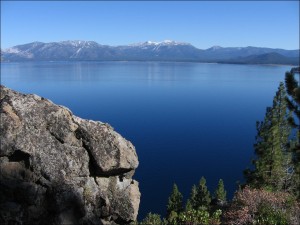 Downhill skiing hasn’t been my cup of tea for years, due to the expense, hassle, and crowds. But I have fond memories of skiing when I was young.
Downhill skiing hasn’t been my cup of tea for years, due to the expense, hassle, and crowds. But I have fond memories of skiing when I was young.
Now it looks like skiing may soon become just a memory for everyone, at least in the western United States. Climate change models predict increased warming and droughts, leading to less snowfall and more rain and flooding.
This year in the mountain west particular has been uniquely and historically awful, and the future looks even worse:
Even with technology and financial wherewithal, the resorts probably can’t win. “Snowmaking is not the answer,” says Porter Fox, author of Deep: The Story of Skiing and the Future of Snow. “It’s a stopgap measure to keep the ski resort industry from collapsing.” When you’re skiing on machine-made snow, yes, you’re carving turns, you’re sliding downhill, perhaps even flying. You’re in the mountains. You might be with your parents, you might be with your kids. The thing is, on more and more days, you won’t get the real powder you grew up on, the kind of snow that turns ambivalent skiers into die-hards. While resorts will be able to cover over the decline for decades to come, the long-term future of the sport looks just as patchy and thin as the runs at Tahoe in early February.
Another victim of a changing climate, or whatever they call the phenomenon in Florida these days.
Scientists Benjamin I. Cook (NASA Goddard Institute for Space Studies), Toby R. Ault (Cornell University) and Jason E. Smerdon (Columbia University’s Lamont-Doherty Earth Observatory) forecast an “unprecedented 21st century drought risk” in the Southwestern United States due to climate change. The report is published in the new peer-reviewed journal Science Advances, by the American Association for the Advancement of Science. Their methodology:
To gather evidence of past megadroughts, the scientists used thousands of tree-ring records collected over many years by other researchers, as well as the histories of ancient droughts that affected the long-puzzling history of the Anasazi people in the American Southwest.
Those people and their widespread cultures disappeared around 1300 A.D. and the cause of their disappearance has long been disputed by archaeologists. But the tree-ring records and the radiocarbon dates of their plant remains show that they did undergo centuries of alternating heat-induced droughts — climaxed by what has been called the “great drought” of 1276 to 1299 A.D.
In his discussion of the megadrought report, Caldeira recalled visiting Anasazi ruins like Mesa Verde in Arizona and said “it looks like the droughts in store for us later this century will make the droughts that did in the Mesa Verde civilization look like child’s play.”
I think the best response to this forecast comes from Ken Caldeira, a climate scientist at the Carnegie Institution for Science and Stanford University:
“When you stack these model projections against the reconstruction of past climates, the results are so sobering that they have me ready to go out for a drink.”
Happy Friday!
 Tahoe is one of my favorite places on Earth, so I’m doubly concerned about the impact of climate change on the largest alpine lake in North America. A few weeks ago, political leaders gathered at the lake shore for an annual discussion of what it will take to preserve it in the face of this environmental threat:
Tahoe is one of my favorite places on Earth, so I’m doubly concerned about the impact of climate change on the largest alpine lake in North America. A few weeks ago, political leaders gathered at the lake shore for an annual discussion of what it will take to preserve it in the face of this environmental threat:
Chief among coming tasks will be efforts to reauthorize the Lake Tahoe Restoration Act, which would provide $415 million for environmental projects around the lake. The act has bipartisan support from the Nevada and California delegations but could face a tough time moving forward through a divided Congress, officials said Tuesday.
I’ve seen the fruits of this money driving around the lake, where stormwater runoff infrastructure and filtration systems have been added on the major roadways. Plus there has been an uptick in some selective logging projects, which are badly needed in the overgrown forest, especially as climate change leads to more severe droughts. Most people don’t realize that the Tahoe Basin was almost entirely clear-cut in the 1870s to supply the Nevada silver mines. So the current forest is a dense collection of mostly fir trees, which displaced the fire-resistant old growth pines that were annihilated by the logging companies.
Let’s hope our leaders successfully raise the funds necessary to protect this treasure from an uncertain future.


